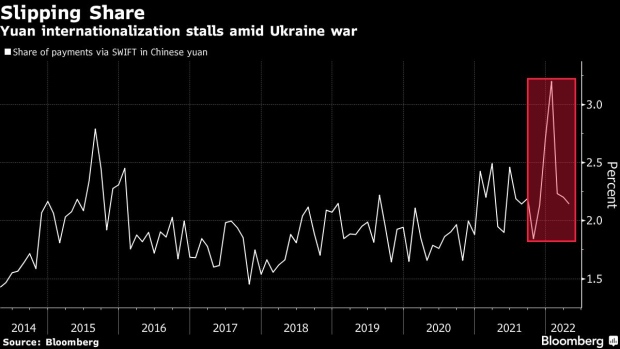May 30, 2022
Yuan-Ruble Trading Surges as America’s Rivals Rebuff Dollar
, Bloomberg News

(Bloomberg) -- The emerging multi-polar world now includes foreign-exchange markets -- as China and Russia, the biggest challengers to U.S. supremacy, boost direct trading between their currencies.
Monthly volumes on the ruble-yuan pair have surged 1,067% to almost $4 billion since the start of the war in Ukraine as the two nations seek to reduce their reliance on the dollar and boost bilateral trade to overcome current and potential U.S sanctions. The spike coincides with a rally in the ruble to a five-year high against the yuan.
That’s a sign Russians are increasingly turning to Chinese goods to replace stalled Western imports and international brands that have vanished from store shelves. For China, it creates the latest boost for the internationalization of the yuan just when growing tensions with the U.S. are slowing that process.
“The main players in the yuan-ruble market are corporations and banks, but there is also a growing interest from retail investors,” said Yuri Popov, a currency and rates strategist at Sberbank CIB JSC. “The volume on the Moscow Exchange’s spot market has surged. This is due to sanctions concerns, as well as the intentions of Russia and China to encourage the usage of national currencies in bilateral trade.”
About 25.91 billion yuan ($3.9 billion) have been exchanged for rubles in the Moscow spot market so far in May, according to Bloomberg calculations. This is almost 12 times the volumes in February, the month Russia invaded Ukraine.
“The ruble-yuan trading is bound to go up more on yuan globalization, and the war just accelerated it,” said Stephen Chiu, a strategist at Bloomberg Intelligence in Hong Kong. “Russia will trade more in yuan and hold more yuan reserves.”
Meanwhile, volume in the dollar-ruble pair sank to the lowest level in a decade, based on its 20-day moving average. The ruble rallied 118% against the greenback between early March and late May even as most traders deserted the pair amid capital controls and forced dollar sales that made it a dysfunctional market.
De-risking From Dollar
Efforts by Russia and China to pursue non-dollar transactions are part of a broader derisking strategy gaining popularity among several emerging markets.
Saudi Arabia plans to price some oil contracts in the yuan, while India is exploring a rupee-ruble payment structure. Global central banks are diversifying reserves, sparking a drop in the dollar’s share in the holdings to 59% in the last quarter of 2020, the lowest in 25 years, according to the International Monetary Fund.
The crippling sanctions on Russia for its invasion of Ukraine have highlighted China’s own vulnerability to US action. Any geopolitical dispute between them could isolate China’s economy from the dollar-dominated financial system, while pushing other nations and foreign investors to prune yuan holdings.
For Russia, the purpose is immediate survival. The nation depends on China more than on the US to keep its trade flowing. The world’s second-biggest economy accounts for a quarter of all the merchandise Russia imports, while the US accounts for less than 11%.
“Russia has a very weak domestic manufacturing industry; so the sanctions mean that it will necessarily have to rely more on China for machinery and consumer goods,” said Alvin Tan, the head of Asia currency strategy at RBC Capital Markets in Singapore. “At the same time, Chinese buyers are being enticed by discounts on Russian commodity exports.”
Despite recent shifts, the dollar remains the world’s most favorite medium of exchange and the main trading pair for most currencies including the ruble. In fact, after Russia’s central bank signaled last week that it wants a weaker currency, daily ruble-dollar volumes recovered to normal levels. As for China, the share of yuan in international transactions remains minuscule, falling further since the war started.
“Larger central banks may be more reluctant to hold the yuan due to potential Western sanctions risk and the corresponding need for China to reimpose capital controls on foreigners,” Gene Frieda, a strategist at Pacific Investment Management Company LLC, wrote in a note last month. “The yuan should continue to attract reserve flows from smaller countries that China dominates as a trade partner.”
©2022 Bloomberg L.P.







